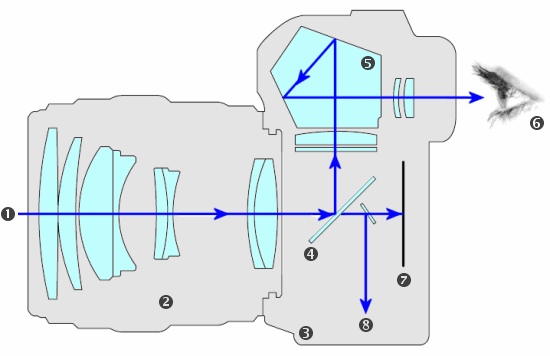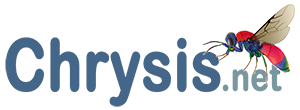Last updated on August 24th, 2020
What is a camera
A camera is a device used to record an image of a landscape or a subject, by exposing a light-sensitive support like a film or a digital sensor.

A modern camera is made of a camera body and a lens which can be either fixed or interchangeable. Between the lens and the camera there is an iris diaphragm which is (electro)mechanically controlled by the shutter. The cameras equipped with an internal mirror are called reflex, and they allow the direct view of a framed scene through the viewfinder and the lens. The same scene seen through the viewfinder will be then exposed on a film or a sensor.
Cameras with interchangeable lenses are called SLR (Single Lens Reflex). Most professional cameras used today are SLRs of different formats (35mm, medium format, large format, etc.).
The optical path
Here is the scheme of the optical path on a reflex camera: the light (1) enters the body (3) through the lens (2) and then reaches the reflex mirror (4) which is on a stand-by position. The mirror deflects the light beam upwards, where the pentaprism (5) through the viewfinder enables the viewing of scenes as captured by the lens (6). The mirror, which is translucent, allows part of the light beam to pass towards the film or the exposure sensor (7) and the image analysis sensors (8). The film or the sensor receives 100% of the light beam when the shutter, triggered by the shutter button, lifts upwards the mirror and the diaphragm closes at the aperture value set for that shot.


In a non-reflex camera, more commonly known as compact camera, the lens is fixed, not interchangeable. There are also less functions available compared to an SLR. Moreover, the optical viewfinder does not reflect the exact same scene captured by the lens, being shifted compared to the optical axis: such deviation is called parallax error. Although minimal at medium to long distances, the parallax error can be critical in close-up photography where the risk of recording a scene that is significantly different from the framed one is higher.
However, the need of framing the scene using the viewfinder has disappeared with the introduction of digital compacts, which allow the user to see the scene projected directly on the LCD screen or on an electronic viewfinder (EVF), like in mirrorless cameras.
Copyright, Authorship, and Ownership statements
All text and images are copyright ©️ Chrysis.net unless otherwise stated - please see individual cases for authorship and copyright details. The specimens pictured are from the authors' or other collaborators' personal collections and from the collections of various museums. Unless otherwise specified, the whole content of this web site is for personal, non-commercial, scientific, and educational purposes given proper accreditation to the page from which they were derived are provided, and under Chrysis.net Terms and Conditions.
For citation purposes
Agnoli G.L. (2025) Chrysis.net Photo Handbook - The Camera, in: Chrysis.net website. Interim version 30 April 2025, URL: https://www.chrysis.net/photography/camera/.




